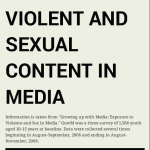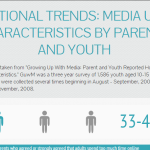For years now, the Internet has been recognized as a powerful tool for social support. Whether it is Facebook, Twitter, or email, people are using the Internet to communicate with their family and friends every day. This may be an especially important resource for young people who may not have as strong social support from people in real life. A growing community that is using the internet as a support system are lesbian, gay, and bisexual (LGB) youth. In fact, a study conducted in Australia found that the LGB youth they talked with were more likely to receive support online than offline.[1] Recently, the Center for innovative Public Health along with collaborators at Latrobe University and the University of New Hampshire, set out to better understand how the online world affects the … [Read more...]
The Top 5 Myths of Cyberbullying
We all ‘know’ about cyberbullying. How much of it is true, though? Most of us have heard about it. We are all concerned about it. But not many of us know the facts about it. Cyberbullying has been a recent and rising concern for parents, communities, and healthcare and education professionals alike. For the most part, we learn what we know about cyberbullying from news sources. With stories linking cyberbullying to suicides, schools monitoring social media feeds, and articles warning us about the dangers of the internet, it is no wonder that we are all deeply concerned. Moreover, many of us are confused about what it all means and how we should be educating youth about cyberbullying. In the end, we’re left feeling like all youth are at high risk for cyberbullying; so when it comes to … [Read more...]
The intersection between violent media and weapon carrying
Adolescents who play violent video and computer games are more than four times as likely as those who play non-violent games to carry a weapon to school in the past month. Just over one in twenty high school students have carried a weapon to school in the past month. Research suggests that youth who carry weapons are more likely to be aggressive and engage in behaviors such as fighting, substance use, and being suspended from school. Some studies have also found that youth who are being bullied or otherwise victimized may bring a weapon to school for ‘protection.’ Beyond behavior and experiences, less is known about exposures, particularly the role that violent media may play in weapon carrying. We address this very question in a study just released in the journal, Aggressive … [Read more...]
Family Matters: Youth Exposure to Violence and Sex in Media
Infographic on youth exposure to violence and sex in media Researchers, public policy officials, and the general public as a whole have long been concerned about the consequences of youths’ exposure to violence and sex in the media. Recent studies have documented the explosion of different types of media available to youth [1, 2] and the widespread presence of violence in these media outlets.[3] With the increase in new media, it is important to first gain a current understanding of how many youth are exposed to violent and sexual content and where this content exposure is occurring (e.g., video games, television, Internet websites) before further investigation into the consequences of such exposure. We examined the frequency of youth exposure to violent and sexual content in media … [Read more...]
Five Facts You Need to Know About Youth and Sex
Sexual violence usually emerges around the age of 16. It’s normal as parents to not want to think about your child having sex, let alone being sexually violent or forcing others to do things sexually. Unfortunately, our recent study published in JAMA Pediatrics suggests that not only do we need to be thinking about sexual violence, we need to be talking with our children about it as well. [1] Here are five things that you need to know about young people and sexual violence: 1. Almost one in ten youth are perpetrators. Nine percent of youth between the ages of 14 and 21 have admitted to making someone do something sexual when they knew that the other person did not want to. (This is 9% of *all* youth – not just those who are having sex) 2. We asked youth who said they have tried … [Read more...]
1 in 10 Youth Have Perpetrated Sexual Violence
Youth are perpetrating sexual violence more often than you might think Today in JAMA Pedeatrics, our study “Prevalence Rates of Male and Female Sexual Violence Perpetrators in a National Sample of Adolescents,” was published. This very important study reveals that 9% of young people have made or tried to make someone do something sexual – including having sex – when they knew the other person did not want to. Findings serve as a call of action for all of us – parents, teachers, researchers – to talk to our young people about what healthy and unhealthy sex is. To learn more about the study find the press release here. Acknowledgements: Thank you to Jennifer Renzas for her contributions to this blog. … [Read more...]
The Internet: Sex Ed Class for Teens
How are teens answering their questions about sex? Sex education can be a touchy topic. For parents, it can be tricky and even awkward to talk about sex with their teens. The politics surrounding the subject make it difficult for many schools to comprehensively address sex education as well. This makes it challenging for young people to access accurate and relevant information necessary to keep themselves healthy. For youth who are lesbian, gay, bisexual, queer or questioning (LGB), access is even more limited. In fact, two in three LGB teens in a recent survey felt that the topics covered in sex ed at their school was not relevant to them. Even more stigmatizing, a recent study revealed that 12% of LGB youth felt that their schools discussed non-vaginal sex in a negative manner. … [Read more...]
How is Your Teen Using the Internet to Find Information?
Think all teens use the internet the same way? Think again. Teens today are using the internet more than ever as a source for information and connection to others. They are using it to create a world beyond their physical one, providing a social network and support in places where it may be lacking in person. Today, the Gay, Lesbian, & Straight Education Network (GLSEN) releases a report on LGBT teens and the Internet titled, “Out Online: The Experiences of Lesbian, Gay, Bisexual and Transgender Youth on the Internet.” Findings show that the internet is a resource for information, a support system, and a source of bullying and harassment for LGBT teens. LGBT teens are getting health information online to supplement what may be lacking in health classes. For example, more than one … [Read more...]
Dating in the 21st Century: How Technology is Leading People’s Search for Love
Does online dating help us find love? We all, or at least many of us, remember the classic Tom Hanks and Meg Ryan movie, “You’ve Got Mail.”[1] For those of you who do not, it was one of the first movies to integrate online dating into the story line. In this 1998 classic, Ryan and Hanks send emails back and forth with the iconic AOL, “You’ve Got Mail” notification pinging away. With each new email, the two are able to talk about their problems, share pieces of themselves, and form a strong emotional bond. [1] Far from being ‘creepy’ or antisocial, the movie shows how technology can facilitate healthy romantic relationships. Fast forward to now - some 15 years later - and technology-facilitated dating has evolved dramatically. And it continues to do so. In just the past 5 years, we have … [Read more...]
Family Matters: Common Rules for Household Media Use
What are the most common household rules for kids using media at home? Do you know what percentage of youth know how to get around or disable the blocking software on their home computers? Find out the answer and more information in this infographic based on the Growing Up With Media: Parent and Youth Reported Household Rules Characteristics report: http://infogr.am/804444202f18-2220/ … [Read more...]








